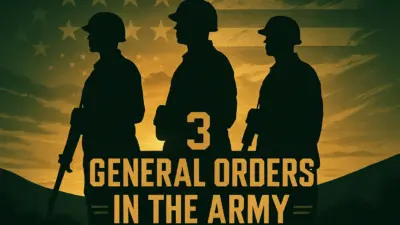Serving in the United States Army is a calling brimming with honor, discipline, and responsibility. Among the first lessons drilled into every new recruit’s mind are the 3 General Orders. These timeless pillars of military life shape the daily conduct and moral compass of every soldier, from the moment they don their uniform to the day they hang up their boots.
If you’re preparing for Army Basic Training, curious about military traditions, or interested in leadership, understanding the Three General Orders can offer priceless insights. Let’s peel back the curtain on this crucial element of military life, exploring not only the specifics but also their broader lessons for anyone seeking to lead, serve, and protect with integrity.
Also read:
Ranger’s Apprentice Books in Order
Ram 1500 Trim Levels in Order: The Ultimate Guide
Mia Sheridan Books in Order: The Ultimate Guide for Readers & Romance Fans
Kyla Stone Books in Order
Kendra Elliot Books in Order: The Ultimate Reading Guide
What Are the General Orders?
The 3 General Orders are straightforward yet profound rules that every U.S. Army soldier must memorize and internalize. These orders guide how one performs duties—especially as a guard or sentry—and ensure that, even in the face of uncertainty, a soldier knows what is expected.
Importance in Military Culture
General orders are not just rules written on a wall. They are lived and breathed every day, becoming second nature for every Private, Sergeant, or seasoned First Sergeant alike. These orders ensure that security, responsibility, and discipline aren’t left to chance—they permeate everything, fostering a culture of alertness and mutual reliance.
Brief Historical Overview
The concept of general orders isn’t unique to the U.S. military. British, Roman, and even Napoleonic armies had similar standing instructions for their guards centuries ago. Today, the U.S. Army has refined these into three powerful statements that stand at the core of military professionalism and effectiveness.
The Three General Orders Explained
Let’s unlock the official texts, core principles, and real-world implications behind each order.
First General Order
Official Text
“I will guard everything within the limits of my post and quit my post only when properly relieved.”
Detailed Explanation & Core Principle
This first order is all about vigilance and accountability. When a soldier takes up a post—whether at the gate of Fort Bragg or the entrance to an ammo depot—everything within that boundary is their responsibility. Leaving—even for a moment—before being properly relieved isn’t just a breach of rules; it’s a breakdown in security that could put everyone at risk.
Real-World Examples
Imagine you’re a private standing guard at the main gate during a rainy night. Even if nature calls or you’re exhausted, you stay put until your relief arrives. If you walk away and something happens—a perimeter breach, theft, or even an unauthorized vehicle—everybody, from the Company Commander to your peers, can be put in jeopardy.
Why Vigilance Matters
- Security: Each post is a potential target; abandoning it can open the door to threats.
- Team Trust: The next shift depends on you to keep the line secure until they arrive.
- Mission Success: Even a single lapse in vigilance can compromise the mission.
Second General Order
Official Text
“I will obey my special orders and perform all my duties in a military manner.”
Interpretation & Importance
The heart of the second order is strict obedience and maintaining a professional bearing at all times. That means following all specific instructions given for your post—whether it’s checking visitors, logging entries, or monitoring equipment—without exception. It’s also about how you behave: remaining sharp, respectful, and alert, proudly representing the U.S. Army and your unit.
Practical Scenarios
Suppose your Platoon Sergeant instructs you to check every contractor’s ID twice or to record vehicle license numbers. Perhaps you’re reminded to salute every officer who passes. No matter how small or repetitive the task, you do it right, every time.
Building Professionalism
- Discipline: Carrying out orders to the letter—every shift, every time.
- Reliability: Your leaders and peers know they can count on you.
- Pride: Doing your duty in a military manner, no matter who is watching.
Third General Order
Official Text
“I will report violations of my special orders, emergencies, and anything not covered in my instructions to the commander of the relief.”
What It Means in Practice
The third order makes it clear that a sentinel’s role isn’t passive. If something happens that isn’t covered in your instruction book, or you observe a violation—say, someone entering a restricted area, a fire, or a suspicious package—you take action by reporting it immediately to your relief commander or supervisor.
Handling Emergencies and the Unexpected
If an unauthorized person tries to sneak onto the base, or if there’s a medical emergency that your special orders don’t mention, initiative becomes key. Maybe your orders cover checking IDs but not how to handle a lost child at your post—still, you step up, inform your superior, and stay engaged.
The Role of Communication
- Timely Alerts: The quicker an incident is reported, the better the response.
- Chain of Command: Respect for reporting structures enables swift, proper action.
- Adaptability: Soldiers must recognize what’s beyond their orders and seek help fast.
The Three General Orders: At a Glance
| General Order | Official Text | Core Principle | Practical Scenario |
|---|---|---|---|
| First General Order | I will guard everything within the limits of my post and quit my post only when properly relieved. | Vigilance & Accountability | Never leave post before relief arrives. |
| Second General Order | I will obey my special orders and perform all of my duties in a military manner. | Obedience & Professionalism | Execute specific instructions exactly. |
| Third General Order | I will report violations of my special orders, emergencies, and anything not covered in my instructions. | Initiative & Communication | Report breaches or emergencies immediately. |
Origin and Historical Context
Early Military Codes
Long before General George Washington marshaled troops at Valley Forge, armies needed rules for guards. Roman sentinels were severely punished for abandoning post, and British Redcoats had standing orders that echo through history.
Evolution to Modern Usage
The U.S. Army formalized its own set of General Orders, refining them over centuries. By World War II, the three orders as we know them today were cemented in Army doctrine, setting American soldiers apart for their clarity, brevity, and impact.
The Role of General Orders in Army Training
Memorization in Boot Camp
Ask any former trainee from Fort Leonard Wood or Fort Jackson, and they’ll tell you: memorizing the General Orders is a rite of passage. Recruits repeat them daily, sometimes in cadence or during midnight fire drills, until they’re second nature.
Assessment and Recitation
During basic training, instructors and drill sergeants will quiz recruits out of the blue. Miss a word or hesitate, and you might find yourself doing pushups. Accuracy—and speed—are critical.
Integration into Daily Duties
Long after training, these orders echo in every guard rotation, patrol, and security check. From the National Training Center in California to overseas outposts like Camp Humphreys in Korea, every soldier is expected to uphold these instructions, regardless of the circumstances.
Lessons Beyond the Guard Post
The beauty of the General Orders is their universal relevance. Here’s how their lessons apply far beyond military fences.
Responsibility and Accountability
When you take up any duty—whether you’re babysitting, watching a storefront, or leading a team at Google—the principle is the same: Own your post, don’t delegate your core duties, and see things through to completion.
Leadership Principles
Great leaders, from General Dwight D. Eisenhower to Colin Powell, have emphasized vigilance, communication, and discipline. The essence of their advice can often be traced to the spirit behind these orders.
Application in Civilian Life
- Security Personnel: Vigilance and the refusal to abandon one’s duties inspire trust and safety in communities.
- Project Management: Obeying special tasks and communicating issues boosts both efficiency and morale.
- Emergency Services: Proactive reporting and decisive action save lives.
Quotes and Anecdotes
Statements from Army Leaders
“Discipline is the soul of an army. It makes small numbers formidable; procures success to the weak, and esteem to all.”
– General George Washington
General Mark A. Milley, the current Chairman of the Joint Chiefs of Staff, has often cited the importance of clear standards and accountability—values embedded in these orders.
Stories Illustrating the Orders in Action
- During the icy winter at Ft. Drum, Sergeant Lisa Thompson refused to leave her post, even when confronted by a blizzard, until her official relief braved the storm. Her vigilance prevented an attempted theft.
- On a peacekeeping mission in Kuwait, a young specialist spotted a faulty generator about to overheat. Remembering the third general order, he promptly reported the emergency, averting a disaster.
Additional Insight: FAQs on the Three General Orders
1. Are the General Orders Ever Changed?
No—though wording may be updated slightly for clarity, the fundamental principles have remained unchanged for decades.
2. What Happens if a Soldier Fails to Uphold an Order?
Depending on the situation, there may be administrative punishment, loss of privileges, or even Uniform Code of Military Justice (UCMJ) proceedings.
3. Do Other Countries Have General Orders?
Many modern militaries, from Britain to India, have their versions of standing orders for guards and sentries, reflecting the universal necessity of vigilance, discipline, and communication.
Conclusion
The 3 General Orders in the Army aren’t dusty artifacts—they are vibrant, decisive, and essential standards shaping every moment of a soldier’s life. By demanding vigilance, obedience, and initiative, they forge individuals who are not just effective service members, but model leaders and citizens far beyond Army gates.
Whether you’re just starting your journey with the U.S. Army, supporting someone who is, or simply looking to instill more discipline and reliability in your everyday life, let the lessons of the General Orders guide you. Remember: Integrity, professionalism, and responsibility never go out of style.



